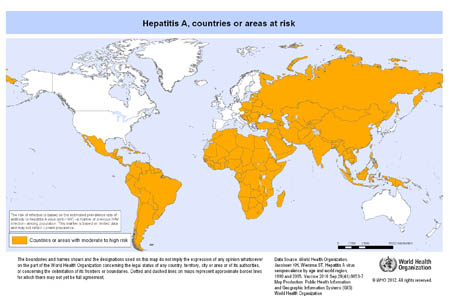Hepatitis A
Hepatitis A is a strain of hepatitis, a disease that causes irritation and inflammation of the liver. It has an incubation period of 15-50 days with an approximate average of 28 days (CDC, 2012). The virus is excreted in fecal matter so most exposure occurs from fecal-to-oral activities or from cross contamination when an infected person fails to wash their hands after a bowel movement. The virus can also be contracted by shellfish that has not been properly prepared (Ontario Ministry of Health, 2012). Hepatitis A can also be contracted through sharing dirty needles (Health Canada, 2012).
Where is Hepatitis A most prevalent?
 While cases can occur anywhere, it is much more common in areas with poor water and food hygiene. If you plan on travelling be aware what places are considered to be a higher risk at this time. Currently, India, Pakistan, Bangladesh, Nepal, Africa, the Middle East, Central & South America, Mexico, and parts of the far east are considered to be at a higher risk (Health Canada, 2012).
While cases can occur anywhere, it is much more common in areas with poor water and food hygiene. If you plan on travelling be aware what places are considered to be a higher risk at this time. Currently, India, Pakistan, Bangladesh, Nepal, Africa, the Middle East, Central & South America, Mexico, and parts of the far east are considered to be at a higher risk (Health Canada, 2012).
Hepatitis A Facts
Prevention
Simple prevention techniques are employed using diligence in hand washing and avoiding dirty water. Be mindful of any situation where you are in close quarters where transmission can occur rapidly, such as daycares or restaurants. If travelling be sure to avoid undercooked fish and meat, dairy products, and buying food from street vendors. It is important to remember that the virus can be transferred by dirty water and that it can survive in ice cubes. Water can be made safe by boiling for a minimum of one minute (PubMed Health, 2012).
Vaccines are available for this virus. You should consult with your doctor on whether the vaccine is right for you. Anyone with severe allergies or recovering from an unrelated illness may not be the best candidate. Side effects of the vaccine should also be considered; they can range from mild to severe. Vaccine side effects can include:
- soreness where the shot was given (about 1 out of 2 adults, and up to 1 out of 6 children)
- headache (about 1 out of 6 adults and 1 out of 25 children)
- loss of appetite (about 1 out of 12 children)
- tiredness (about 1 out of 14 adults) (CDC, 2012)
- serious allergic reaction, within a few minutes to a few hours after the shot (very rare). (CDC, 2012)
Article References
CDC. (2012). Sexually Transmitted Diseases: Vaccine-Preventable STDs. Retrieved 03 21, 2012, from Centers for Disease Control and Prevention: http://www.cdc.gov/std/treatment/2010/vaccine.htm#a1
CDC. (2012). Vaccine Information Sheet: Heptatitis A Vaccine. Retrieved 03 21, 2012, from Center for Disease Control and Prevention: http://www.cdc.gov/vaccines/pubs/vis/downloads/vis-hep-a.pdf
Health Canada. (2012). Hepatitis. Retrieved 03 21, 2012, from Health Canada: http://www.hc-sc.gc.ca/hc-ps/dc-ma/hep-eng.php
Health Canada. (2012). Hepatitis A. Retrieved 03 21, 2012, from Public Health Agency of Canada: http://www.phac-aspc.gc.ca/tmp-pmv/info/hepa-eng.php
Ontario Ministry of Health. (2012). Ontario Ministry of Health and Long Term Care. Retrieved 03 21, 2012, from DISEASES : Hepatitis A: http://www.health.gov.on.ca/english/public/pub/disease/hepatitisa.html
PubMed Health. (2012). PubMed Health. Retrieved 03 21, 2012, from Hepatitis A: http://www.ncbi.nlm.nih.gov/pubmedhealth/PMH0001323/
Image References
Someone else's art deserves recognition! The images presented in this article were borrowed from the following places:
Header Image: http://topnews.net.nz/data/hepatitis-a1.jpg | Retrieved May 1, 2015
Image 1: http://gamapserver.who.int/mapLibrary/Files/Maps/Global_HepA_ITHRiskMap.png | Retrieved May 1, 2015